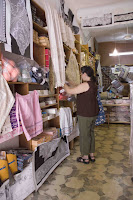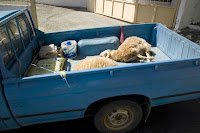It's exactly a month ago that we left for Crete...and we've been back home in Winnipeg since September 3rd, so this will be the last vicarious vacation post. (Sadly, I have lost all of the magical Greek vacation feeling to errands and house repairs, etc. Better find time for a Greek coffee or something, I guess!)
The last time we were in Crete, in 2006, I wrote
this post. It said a lot of reflective things. Surprisingly, I found myself getting ready to post something very similiar, so I'll be quoting some from that post this time!

In Chania, and in Crete generally, there are layers of history, religion, and culture. They appear like this door--an entryway into a past and a history that is hard to understand for a person from the New World. This doorway (probably to a Venetian townhouse, or maybe Ottoman era?) is chained, but you can see right inside the building. The building is basically abandoned and in ruins. It's empty, just waiting to be restored...and since it's a townhouse, there are thriving businesses and houses right near by. It's part of the magic of Crete. Honestly, I can't figure why the new holiday homes are being built far out of town when there are places like this left to be restored right in town!
One of our stops in Chania was to go see
Etz Hayyim. (check out that website, it's fascinating!) We happened upon this synagogue the last time we were in Crete, and here's what I said about it then:
"Crete had a very old Jewish community, thousands of years old, but when the Nazis occupied Crete, they rounded up the 300 Jews on the island and put them aboard a ship to Auschwitz Concentration Camp, along with hundreds of Cretan members of the resistance. The ship was torpedoed by the English and everyone perished. (at least they were saved the inhumane death by deprivation at the camps. Baruch Dayan Ha-Emet*)
**Baruch Dayan Ha-Emet is Hebrew. It means, "Blessed is (G-d) the righteous Judge." It's said in traditional Judaism whenever one hears of a death--because only G-d decides when it is someone's time to die.The synagogue was immediately looted and taken over by squatters. Over the years, there were stray animals, a chicken coop and dumps on the site of this congregation. In the mid to late '90's, an international and local inter-faith effort was made to restore the synagogue, because without this restoration, the Nazis would have succeeded--erasing thousands of years of Jewish ritual and culture."

This time, we returned to visit the building again. I'd found it an extremely moving place. Somehow, one could sense the centuries of people who'd been there, worshipping, celebrating with family and friends, and mourning, too.
I took a few more photos of things that I found interesting or moving. This is the courtyard, which I mentioned last time:
"Generally, Jews bury their dead in cemeteries away from places of worship, but during a time of political unrest, several very esteemed

rabbis were buried in one of the courtyards within the walls of the congregation. The date of the earliest seems to be 1710, and we were able to visit this grave, too."
"There are now daily prayers again with mixed seating, and it's a peaceful sanctuary, sheltered in a verdant courtyard. There's an old alcove in the wall for ritual handwashing."
"There is a library filled with books on religion, in many languages, in an area that used to be one of the women's sections." (Historically, Jewish women and

men sat apart during religious services. Today, this is only true for more traditional, Orthodox services.) This gallery, with the lattice screening, is an architecture that is borrowed from Islamic tradition...a separate area for women to sit and see what is happening without being a part of it. (not all Jewish women's sections look like this--it varies from country to country and culture to culture)
"There is a restored mikveh, a ritual bath, that was so inviting that I wanted to use it....Apparently it is still used by brides and there is room there for a traditional Middle Eastern Henna party for the bride, which used to be

usual in Crete." (This is the photo of the ritual bath. The stick at the entry is to keep tourists from walking into the water! To the right, there is a long bench seat built into the bath for the female members of a bride's family to sit.)
"There are very few Jews in Crete now. The area around the synagogue was, at times, a ghetto where Jews were forced to live, but while the old buildings still remain, there are no traces of that civilization left."
I feel a bit bittersweet about ending the vacation with this posting, but it was one of the last things we did in Crete on our way home! Commemorating tradition is sometimes a thing of mixed emotions. Here's what I said in my 2006 post:
"I was really touched, enriched, and affected by this trip. In many ways, it helped reinforce much of the history I studied in college and in graduate school. I saw interfaith and intercultu

ral dialogue in a tangible way that is hard to gather from graduate seminars and old microfilm. Yes, I'd studied much of these historical occupations and cultural exchanges, but in Crete, you can see it in the people, in the landscape and buildings, and in the daily custom. This is a Greek Orthodox environment where one can eat a meal in an old Turkish Hamam, look at Christian art influenced by Islam, and see Jewish traditions, distinct and yet influenced by the Muslim and Christian environment around them."
The most important thing I gleaned from a second trip is the layering and richness of that deep cultural and religious exchange. I saw it in the textiles at the Sitia Folklore Museum, and even further in the food traditions. I've read more about Mediterranean and Middle Eastern foods since then, and I saw even more in the mingling on menus this time. (Menus written in Greek, English, French, German, and Italian!)
I hope you've enjoyed hearing about my trip to Crete! I'm off to make a Middle Eastern roasted eggplant salad as part of our supper...I bring a little more of Crete home with me each time we go. Labels: architecture, Crete, culture, Etz Hayyim, religious diversity, synagogue









